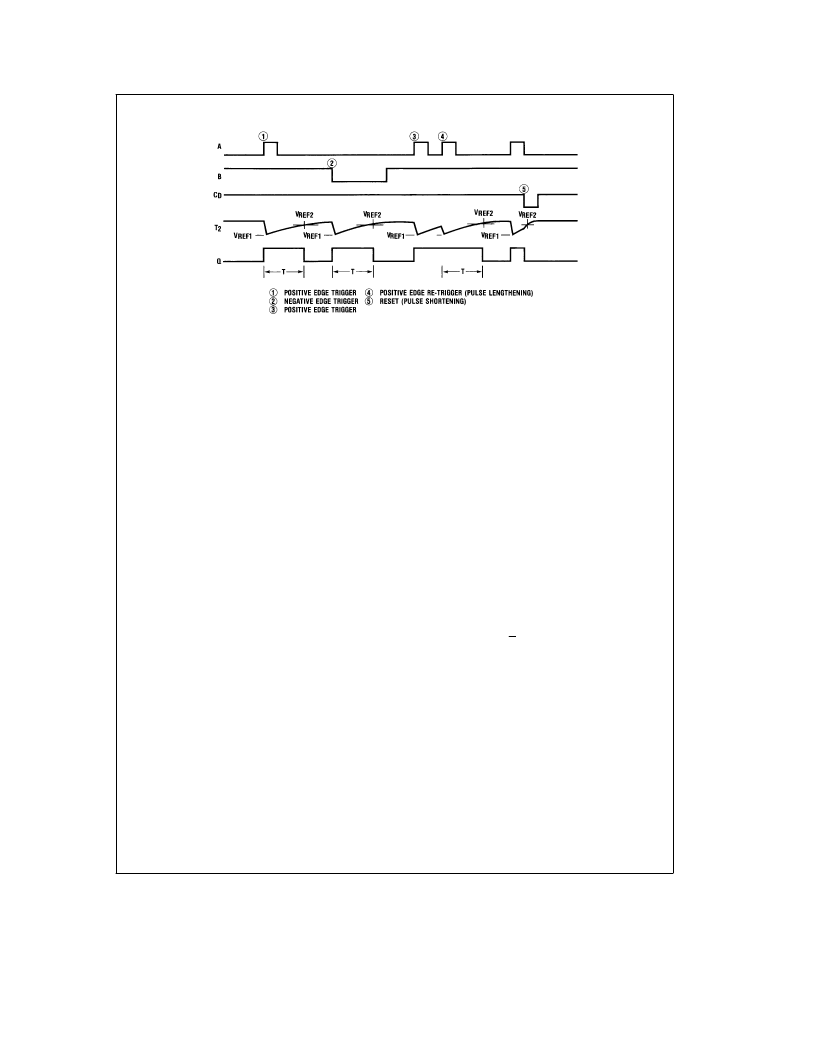- 您現(xiàn)在的位置:買(mǎi)賣(mài)IC網(wǎng) > PDF目錄379820 > CD4538BCWM (FAIRCHILD SEMICONDUCTOR CORP) Dual Precision Monostable PDF資料下載
參數(shù)資料
| 型號(hào): | CD4538BCWM |
| 廠商: | FAIRCHILD SEMICONDUCTOR CORP |
| 元件分類(lèi): | 諧振器 |
| 英文描述: | Dual Precision Monostable |
| 中文描述: | 4000/14000/40000 SERIES, DUAL MONOSTABLE MULTIVIBRATOR, PDSO16 |
| 封裝: | 0.150 INCH, MS-012, SOIC-16 |
| 文件頁(yè)數(shù): | 5/10頁(yè) |
| 文件大?。?/td> | 237K |
| 代理商: | CD4538BCWM |

Theory of Operation
TL/F/6000–4
FIGURE 2
Trigger Operation
The block diagram of the CD4538B is shown in Figure 1,
with circuit operation following.
As shown inFigures 1 and2, before an input trigger occurs,
the monostable is in the quiescent state with the Q output
low, and the timing capacitor C
X
completely charged to
V
DD
. When the trigger input A goes from V
SS
to V
DD
(while
inputs B and C
D
are held to V
DD
) a valid trigger is recog-
nized, which turns on comparator C1 and N-Channel tran-
sistor N1
j
. At the same time the output latch is set. With
transistor N1 on, the capacitor C
X
rapidly discharges toward
V
SS
until V
REF1
is reached. At this point the output of com-
parator C1 changes state and transistor N1 turns off. Com-
parator C1 then turns off while at the same time comparator
C2 turns on. With transistor N1 off, the capacitor C
X
begins
to charge through the timing resistor, R
X
, toward V
DD
. When
the voltage across C
X
equals V
REF2
, comparator C2 chang-
es state causing the output latch to reset (Q goes low) while
at the same time disabling comparator C2. This ends the
timing cycle with the monostable in the quiescent state,
waiting for the next trigger.
A valid trigger is also recognized when trigger input B goes
from V
DD
to V
SS
(while input A is at V
SS
and input C
D
is at
V
DD
)
k
.
It should be noted that in the quiescent state C
X
is fully
charged to V
DD
, causing the current through resistor R
X
to
be zero. Both comparators are ‘‘off’’ with the total device
current due only to reverse junction leakages. An added
feature of the CD4538B is that the output latch is set
via the input trigger without regard to the capacitor voltage.
Thus, propagation delay from trigger to Q is independent of
the value of C
X
, R
X
, or the duty cycle of the input waveform.
Retrigger Operation
The CD4538B is retriggered if a valid trigger occurs
l
fol-
lowed by another valid trigger
m
before the Q output has
returned to the quiescent (zero) state. Any retrigger, after
the timing node voltage at pin 2 or 14 has begun to rise from
V
REF1
, but has not yet reached V
REF2
, will cause an in-
crease in output pulse width T. When a valid retrigger is
initiated
m
, the voltage at T2 will again drop to V
REF1
before
progressing along the RC charging curve toward V
DD
. The
Q output will remain high until time T, after the last valid
retrigger.
Reset Operation
The CD4538B may be reset during the generation of the
output pulse. In the reset mode of operation, an input pulse
on C
D
sets the reset latch and causes the capacitor to be
fast charged to V
DD
by turning on transistor Q1
n
. When
the voltage on the capacitor reaches V
REF2
, the reset latch
will clear and then be ready to accept another pulse. If the
C
D
input is held low, any trigger inputs that occur will be
inhibited and the Q and Q outputs of the output latch will not
change. Since the Q output is reset when an input low level
is detected on the C
D
input, the output pulse T can be made
significantly shorter than the minimum pulse width specifica-
tion.
5
相關(guān)PDF資料 |
PDF描述 |
|---|---|
| CD4538 | Quadruple Operational Amplifier 14-TSSOP 0 to 70 |
| CD4541 | CMOS PROGRAMMABLE TIMER HIGH VOLTAGE TYPES(20V RATING) |
| CD4541BH | CMOS PROGRAMMABLE TIMER HIGH VOLTAGE TYPES(20V RATING) |
| CD4541BC | Programmable Timer |
| CD4541 | Programmable Timer |
相關(guān)代理商/技術(shù)參數(shù) |
參數(shù)描述 |
|---|---|
| CD4538BCWM/A+ | 制造商:未知廠家 制造商全稱(chēng):未知廠家 功能描述:Monostable Multivibrator |
| CD4538BCWM_Q | 功能描述:單穩(wěn)態(tài)多諧振蕩器 Dual Prec Monostable RoHS:否 制造商:Texas Instruments 每芯片元件:1 邏輯系列:LVC 邏輯類(lèi)型:Monostable Multivibrator 封裝 / 箱體:SSOP-8 傳播延遲時(shí)間:18.6 ns 高電平輸出電流:- 32 mA 低電平輸出電流:32 mA 電源電壓-最大:5.5 V 電源電壓-最小:1.65 V 最大功率耗散: 最大工作溫度:+ 85 C 最小工作溫度:- 40 C 封裝:Reel |
| CD4538BCWMX | 功能描述:單穩(wěn)態(tài)多諧振蕩器 Dual Prec Monostable RoHS:否 制造商:Texas Instruments 每芯片元件:1 邏輯系列:LVC 邏輯類(lèi)型:Monostable Multivibrator 封裝 / 箱體:SSOP-8 傳播延遲時(shí)間:18.6 ns 高電平輸出電流:- 32 mA 低電平輸出電流:32 mA 電源電壓-最大:5.5 V 電源電壓-最小:1.65 V 最大功率耗散: 最大工作溫度:+ 85 C 最小工作溫度:- 40 C 封裝:Reel |
| CD4538BD | 制造商:未知廠家 制造商全稱(chēng):未知廠家 功能描述:Logic IC |
| CD4538BE | 制造商:RCA 功能描述: |
發(fā)布緊急采購(gòu),3分鐘左右您將得到回復(fù)。